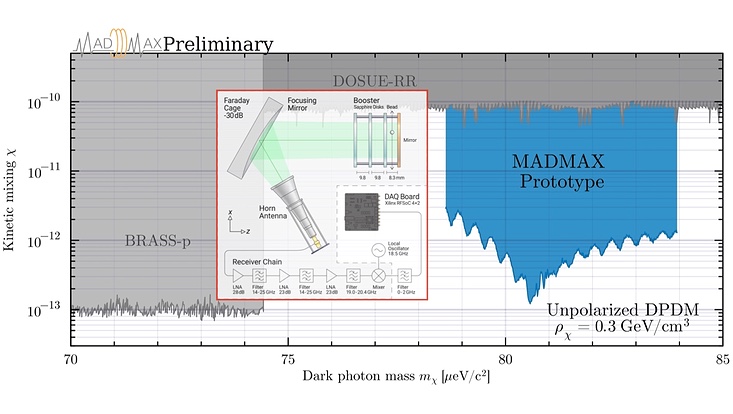MADMAX Prototype Searches for Dark Photon Dark Matter with Thousand-fold Improvement
19 August 2024

Photo: MADMAX Collaboration – Egge, J. et al. (2024)
MADMAX (Magnetized Disc and Mirror Axion eXperiment) at University of Hamburg & DESY is being developed to look for Galactic axion dark matter using a dielectric boosted haloscope. Recently, the MADMAX Prototype experiment at the shielded laboratory hall SHELL produced its first science result by searching for dark matter in the form of dark photons. Using a stack of three sapphire disks with a mirror, they have improved our knowledge of the dark photon kinetic mixing parameter by up to 1000 times compared to previous searches.
Extremely light-weight particle candidates for dark matter include ‘dark photons’, also known as hidden photons, which are motivated by extensions to the standard model of particle physics. In these extensions, an additional gauge symmetry is postulated, and if this symmetry is broken it will endow the dark photons with a light mass mχ. This light particle will predominantly interact with standard model particles via a ‘kinetic mixing’ with the ordinary massless light particle – the photon. To search for dark photon dark matter (DPDM) we would like to measure or better constrain the level of such mixing or interaction which is denoted by χ or the kinetic mixing angle. It is this quantity which has recently been searched for and constrained by the MADMAX Prototype.
At the SHELL (Shielded Experimental Hall) at UHH Bahrenfeld, placed inside a Faraday cage to isolate from radio frequency interference, is the MADMAX Prototype setup consisting of a mirror next to a set of three sapphire disks which act as a dielectric signal booster. To search for axion dark matter, the full MADMAX experiment will require a strong external static magnetic field. However, the prototype is sensitive to dark photon dark matter even without any applied magnetic field. This is because dark photon dark matter (DPDM) will create an oscillating dark electric field which produces radio photons at the surface of a metallic mirror. These radio photons will be produced at a radio frequency proportional to the dark photon’s light mass.
The MADMAX dielectric haloscope concept has the distinct advantage of decoupling the volume where dark photons convert to radio photons from the wavelength probed (or mass searched for) by placing resonant dielectric disks to amplify the radio photon signal. By controlling the spacing between the disks, the boost factor can be tuned allowing both broadband and resonant searches for dark matter particles. This opens up a previously inaccessible range of masses for dark matter searches.
For the MADMAX Prototype search for DPDM, a single fixed booster configuration was used with three 1 mm thick sapphire disks and an aluminum mirror, all of 30 cm diameter. The disks are extremely planar with a surface unevenness (rms) below 50 μm. The dark photon induced radio signal is coupled to a horn antenna via a mirror and then amplified, filtered, down-converted and digitized in a range between 19.01 to 20.30 GHz finally leading a to dark photon search in the mass range between 78.62 to 83.95 μeV.
The MADMAX team reports in their submitted paper, led by Cluster of Excellence Quantum Universe Ph.D. student Jacob Egge, that they improve our knowledge of the kinetic mixing parameter χ, over previous searches, by over a factor 30 times across their whole mass range and by almost a 1000 times improvement at a dark photon mass of 80.57 μeV. The experiment was sensitive to only one polarization of the DPDM, in the zenith-pointing direction.
The biggest source of systematic uncertainty in the experiment has also been investigated to come from the bead-pull method of inserting a bead into the booster to measure the induced electric field. Further, the team had to excise 22 very narrow radio frequency bands from the data analysis, due to considerable interference, even after good shielding suppression, plausibly originating from Hamburg airport’s surface-monitoring radar.
These significant results are the first physics results from the MADMAX Prototype and they demonstrate the feasibility of MADMAX’s innovative dielectric haloscope concept. Further improvements are planned by adding more dielectric disks, reading noise with a cryostat and implementing a tunable booster with motorized disk control. This will lead to even greater range and sensitivity to dark photon dark matter.
